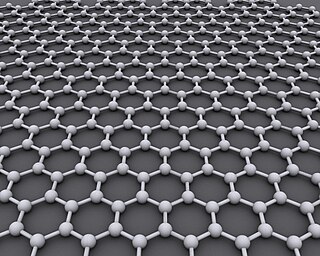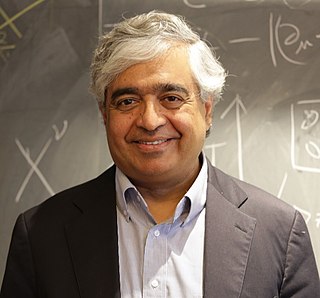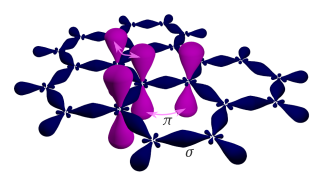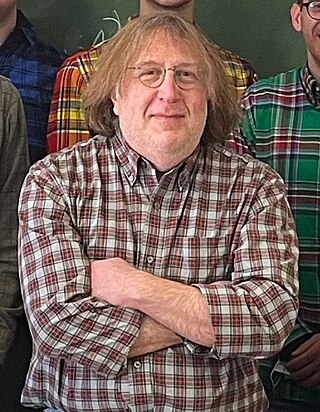
Graphene is an allotrope of carbon consisting of a single layer of atoms arranged in a hexagonal lattice nanostructure. The name is derived from "graphite" and the suffix -ene, reflecting the fact that the graphite allotrope of carbon contains numerous double bonds.

Mott insulators are a class of materials that are expected to conduct electricity according to conventional band theories, but turn out to be insulators. These insulators fail to be correctly described by band theories of solids due to their strong electron–electron interactions, which are not considered in conventional band theory. A Mott transition is a transition from a metal to an insulator, driven by the strong interactions between electrons. One of the simplest models that can capture Mott transition is the Hubbard model.

In physics, topological order is a kind of order in the zero-temperature phase of matter. Macroscopically, topological order is defined and described by robust ground state degeneracy and quantized non-Abelian geometric phases of degenerate ground states. Microscopically, topological orders correspond to patterns of long-range quantum entanglement. States with different topological orders cannot change into each other without a phase transition.

Sankar Das Sarma is an India-born American theoretical condensed matter physicist, who has worked in the broad research topics of theoretical physics, condensed matter physics, statistical mechanics, quantum physics, and quantum information. He has been a member of the department of physics at University of Maryland, College Park since 1980.
Ferromagnetic superconductors are materials that display intrinsic coexistence of ferromagnetism and superconductivity. They include UGe2, URhGe, and UCoGe. Evidence of ferromagnetic superconductivity was also reported for ZrZn2 in 2001, but later reports question these findings. These materials exhibit superconductivity in proximity to a magnetic quantum critical point.

Subir Sachdev is Herchel Smith Professor of Physics at Harvard University specializing in condensed matter. He was elected to the U.S. National Academy of Sciences in 2014, and received the Lars Onsager Prize from the American Physical Society and the Dirac Medal from the ICTP in 2018. He was a co-editor of the Annual Review of Condensed Matter Physics from 2017–2019.
Katsunori Wakabayashi is a physicist at the International Center for Materials Nanoarchitectonics (MANA), National Institute for Materials Science (NIMS), Japan. He is an authority and leading researcher in nanotechnology in the area of energy states of single wall carbon nanotubes (SWCN). His research is notable for the edge effects of the nanographene materials, which is a part of the single layer graphene. He obtained his Ph.D. in 2000 from University of Tsukuba in Japan. From 2000 to 2009 he was an assistant professor at Department of Quantum Matter in Hiroshima University, Japan. From 2009, he is an Independent Scientist at International Center for Materials Nanoarchitectonics (WPI-MANA), National Institute for Materials Science (NIMS) in Tsukuba, Japan. Beside the above primary research position, he was a visiting scholar at ETH-Zurich, Switzerland from 2003 to 2005, also had a concurrent position as PRESTO researcher in Japan Science and Technology Agency (JST).

Nicholas Harrison FRSC FinstP is an English theoretical physicist known for his work on developing theory and computational methods for discovering and optimising advanced materials. He is the Professor of Computational Materials Science in the Department of Chemistry at Imperial College London where he is co-director of the Institute of Molecular Science and Engineering.
In physics, the plasmaron was proposed by Lundqvist in 1967 as a quasiparticle arising in a system that has strong plasmon-electron interactions. In the original work, the plasmaron was proposed to describe a secondary peak in the photoemission spectral function of the electron gas. More precisely it was defined as an additional zero of the quasi-particle equation . The same authors pointed out, in a subsequent work, that this extra solution might be an artifact of the used approximations:
We want to stress again that the discussion we have given of the one-electron spectrum is based on the assumption that vertex corrections are small. As discussed in the next section recent work by Langreth [29] shows that vertex corrections in the core electron problem can have a quite large effect on the form of satellite structures, while their effect on the quasi particle properties seems to be small. Preliminary investigations by one of us (L.H.) show similar strong vertex effects on the conduction band satellite. The details of the plasmaron structure should thus not be taken very seriously.
The Fulde–Ferrell–Larkin–Ovchinnikov (FFLO) phase can arise in a superconductor in large magnetic field. Among its characteristics are Cooper pairs with nonzero total momentum and a spatially non-uniform order parameter, leading to normal conducting areas in the superconductor.
Bilayer graphene is a material consisting of two layers of graphene. One of the first reports of bilayer graphene was in the seminal 2004 Science paper by Geim and colleagues, in which they described devices "which contained just one, two, or three atomic layers"
Girsh Blumberg is an Estonian-American physicist working in the experimental physics fields of condensed matter physics, spectroscopy, nano-optics, and plasmonics. Blumberg is an elected fellow of the American Physical Society (APS), an elected Fellow of the American Association for the Advancement of Science (FAAAS) , and a Distinguished Professor of Physics at Rutgers University.
Eva Yocheved Andrei is an American condensed matter physicist, currently a Distinguished Professor and Board of Governors Professor at Rutgers University. Her research focuses on emergent properties of matter arising from collective behavior of many particles, especially low-dimensional phenomena under low temperatures and high magnetic fields.

Fiber network mechanics is a subject within physics and mechanics that deals with the deformation of networks made by the connection of slender fibers,. Fiber networks are used to model the mechanics of fibrous materials such as biopolymer networks and paper products. Depending on the mechanical behavior of individual filaments, the networks may be composed of mechanical elements such as Hookean springs, Euler-Bernoulli beams, and worm-like chains. The field of fiber network mechanics is closely related to the mechanical analysis of frame structures, granular materials, critical phenomena, and lattice dynamics.

Graphene is a semimetal whose conduction and valence bands meet at the Dirac points, which are six locations in momentum space, the vertices of its hexagonal Brillouin zone, divided into two non-equivalent sets of three points. The two sets are labeled K and K'. The sets give graphene a valley degeneracy of gv = 2. By contrast, for traditional semiconductors the primary point of interest is generally Γ, where momentum is zero. Four electronic properties separate it from other condensed matter systems.

David Tománek (born July 1954) is a U.S.-Swiss physicist of Czech origin and researcher in nanoscience and nanotechnology. He is Emeritus Professor of Physics at Michigan State University. He is known for predicting the structure and calculating properties of surfaces, atomic clusters including the C60 buckminsterfullerene, nanotubes, nanowires and nanohelices, graphene, and two-dimensional materials including phosphorene.

Alexander Avraamovitch Golubov is a doctor of physical and mathematical sciences, associate professor at the University of Twente (Netherlands). He specializes in condensed matter physics with the focus on theory of electronic transport in superconducting devices. He made key contributions to theory of Josephson effect in novel superconducting materials and hybrid structures, and to theory of multiband superconductivity.

Randall David Kamien is a theoretical condensed matter physicist specializing in the physics of liquid crystals and is the Vicki and William Abrams Professor in the Natural Sciences at the University of Pennsylvania.
Dov I. Levine is an American-Israeli physicist, known for his research on quasicrystals, soft condensed matter physics, and statistical mechanics out of equilibrium.
The term heterostrain was proposed in 2018 in the context of materials science to simplify the designation of possible strain situations in van der Waals heterostructures where two two-dimensional materials are stacked on top of each other. These layers can experience the same deformation (homostrain) or different deformations (heterostrain). In addition to twist, heterostrain can have important consequences on the electronic and optical properties of the resulting structure. As such, the control of heterostrain is emerging as a sub-field of straintronics in which the properties of 2D materials are controlled by strain. Recent works have reported a deterministic control of heterostrain by sample processing or with the tip of an AFM of particular interest in twisted heterostructures. Heterostrain alone has also been identified as a parameter to tune the electronic properties of van der Waals structures as for example in twisted graphene layers with biaxial heterostrain.










